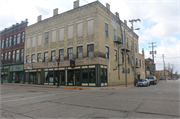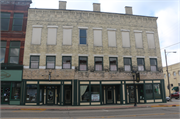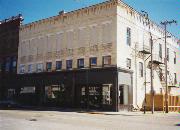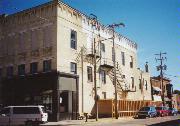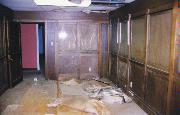Property Record
201/205 E MAIN ST
Architecture and History Inventory
| Historic Name: | J.W. Cole Building |
|---|---|
| Other Name: | Kline's Department Store |
| Contributing: | Yes |
| Reference Number: | 76352 |
| Location (Address): | 201/205 E MAIN ST |
|---|---|
| County: | Jefferson |
| City: | Watertown |
| Township/Village: | |
| Unincorporated Community: | |
| Town: | |
| Range: | |
| Direction: | |
| Section: | |
| Quarter Section: | |
| Quarter/Quarter Section: |
| Year Built: | 1854 |
|---|---|
| Additions: | |
| Survey Date: | 19862020 |
| Historic Use: | large retail building |
| Architectural Style: | Commercial Vernacular |
| Structural System: | |
| Wall Material: | Brick |
| Architect: | |
| Other Buildings On Site: | |
| Demolished?: | No |
| Demolished Date: |
| National/State Register Listing Name: | Main Street Commercial Historic District |
|---|---|
| National Register Listing Date: | 6/2/1989 |
| National Register Multiple Property Name: |
| Additional Information: | A 'site file' exists for this property. It contains additional information such as correspondence, newspaper clippings, or historical information. It is a public record and may be viewed in person at the Wisconsin Historical Society, Division of Historic Preservation-Public History. This is Cole's Block, probably the most historic commercial block on Main Street. Built in 1854 by John W. Cole, the building housed a number of important retail businesses into the twentieth century. Cole's Hall, in the upstairs of the building, was a popular meeting place for fraternal and service groups in the community. Some of the businesses operating in Cole's Block included the important dry goods store of Racek and Jones, between c. 1880-1893; the Achtenhagen and Heilman, later Achtenhagen and Borchardt department store between c. 1899-1915; August Toelke dry goods between c. 1889-1893, and the Watertown, later Wisconsin, Gas and Electric Company between 1907-1921. Cole's Hall was a popular meeting place. Among the many groups that held activities here were the Good Templars, the Knights of Pythias, and the Masons had their Masonic Temple here until the construction of their own hall in 1909. This building is significant for local history under National register criterion A and B; it was the most prominent building constructed for locally significant pioneer businessman, John W. Cole and because it housed a number of retail businesses and social and political groups. The Cole Brothers, John and Lutherm were two pioneers who were responisble for much of the early growth of the community. They opened the first store in 1841. Later Luther Cole concentrated on the milling industry and John W. Cole continued in the commercial area building the store at 116 E. Main and this building. Cole's Block is the most substantial resource related to John W. Cole other than his home. It represents the prominence his commercial career achieved in the community, and his hall offered space for a number of important fraternal groups. This building is both individually historically significant and also contributes to the overall development of commerce in the Main Street Commercial Historic District. Built in 1854 for J.W. Cole to provide larger quarters for his general merchandize trade, the Cole building is a simple large three-story cream brick block ornamented only by a wide corbelled brick cornice at the top of the facade and the west elevation. Plain rectangular windows with flat stone lintels on the second and third floors on the facade and west elevation. Designed to have a community hall on the top floor, the nine-bay Cole Block has been altered by the removal of the original 12 over 12 window frames and exterior wooden shutters. The windows have been filled in with horizontal siding. Originally characterized by a massive iron balcony and exterior iron stairway on the second floor, the building presently has a small iron baclony and an iron fire escape on the west elevation. The original storefront has been removed and a contemporary front continuous with the adjacent building at 205-209 East Main has been added to the building. In addition, the interior space has been incorporated into the commercial space used by the adjacent Kline Department Store. Pressed metal ceilings remain on all floors in the interior. A one-and-a-half story addition is located at the rear of the building. The J.W. Cole building is important as an example of commercial vernacular architecture. Among the better preserved of the simple commercial vernacular brick buildings from the early 1850s period of development, the J.W. Cole building is ornamented only by a corbelled brick cornice. Other good examples of the rather utilitarian early vernacular brick commercial building ornamented only by a brick cornice is the Maldaner and Peterson Store built a few years earlier at 200 E. Main (63-22) and the 1871 Duffy building at 217 E. Main (65-10). Built in 1854 for J.W. Cole, who reportedly organized the first store in Watertown in the 1840s this historic general merchandise store originally was characterized by a large iron baclcony and stairway on the second story extending the full length of the facade and by exterior wooden shutters. |
|---|---|
| Bibliographic References: | (A) Tax Records, City of Watertown, 1850-1910, Area Research Center, Library, University of Wisconsin-Whitewater. (B) Photograph, Folio, City of Watertown, 1887, Archives, Octagon House, Watertown Historical Society. (C) Watertown Chronicle March 8, 1854; April 1, 1854. (D) Watertown City Directories, 1866-1930, Watertown Public Library. |
| Wisconsin Architecture and History Inventory, State Historic Preservation Office, Wisconsin Historical Society, Madison, Wisconsin |

